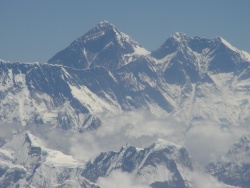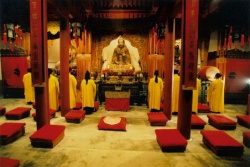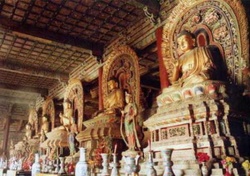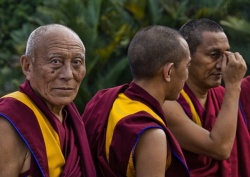Monks by the Qinghai Lake
The following is a group of Monks who work hard to bring luck to the populace. Rising and going to bed with the ringing of Monastery bells, they are well-versed in Buddhist Knowledge. With alms raised, they have set up schools and workshops for Self-sufficiency. With Money thus made, they set to assist people residing around their Monasteries, “bringing luck to the populace”.
Jigmei Gyamcain With the Lhagyia Monastery
NGADAINGYIA
A boy baby was born into a herder’s family in Dawu Township, Maqin County, Golog Tibetan Ethnic Group Autonomous Prefecture, in 1965. He is none other but Jigmei Gyamcain.
Frolicking around grazing sheep for 9 years, the boy went to school for cultural Nourishment. Three years later, the boy proved to be a prodigy clever enough to pass examinations for study in the Preparatory Class of the Qinghai Institute for Nationalities. The chance fizzled out unfortunately as his mother fell sick, and was sick seriously. Acting in accordance with his Parents” wish instead, the boy was tonsured to the Lhagyia Monastery.
Jigmei Gyamcain didn’t give up his study in the Monastery. Instead, he studied whenever chances found him. Though young, he was sent to study in the Tar and Labrang Monasteries and, in September 1986, he was enrolled by the Qinghai Buddhist College (QBC) for three-year study.
In the QBC, Jigmei Gyamcain studied for Grammar and Composition, Logics and Poems. Upon graduation, he furthered his study in the China Tibetan-Language Buddhist College in Beijing.
In 1990, Jigmei Gyamcain, who now had a good command of Chinese, won his diploma as a “university graduate”, and returned to the Lhagyia Monastery after having declined with thanks invitation to stay in Beijing.
Jigmei Gyamcain was invited to teach Tibetan at the Marqin county Tibetan Middle School. He loved the job but was sad to see students sitting in the tattered classrooms.
After a careful research, Jigmei Gyamcain decided to run a private school, and his application was approved by the local government.
His school, built on a sweep of wilderness, covers an area of 887 square meters with an investment of 220,000 yuan, including a bank loan to the tune of 100,000 yuan.
The school, named Jigmei Gyamcain Private School, opened on December 15, 1994. It is staffed with 10 teachers and has a student boy of 86. Jigmei Gyamcain himself serves as the school president, a Teacher and even a chef.
Jigmei Gyamcain is prolific. Over the years, he has published a dozen papers and poems on Tibetan Language and the Tibetan culture in provincial journals. His photograph work, named Snow-Capped Marqin Mountain, won an award at the 1994 national exhibition of Buddhist Art, and was chosen to show in Japan that year.
Living Buddha Reqin Cering
HANGUAN QOIGYIA
Reqin Cering, born in 1947 in Dianbu Village, Chengdo County, Yushu, was determined as a Living Buddha in the early 1950s. In May 1995, he was elected Vice-Chairman of the CPPCC Yushu Committee.
“We used to live on alms,” recalled the Living Buddha. “However, we have managed to raise enough Money to build the Monastery by seeking alms, mining gold, transporting sand and doing business.
“We purchased two trucks and one jeep. In this Way, we have more than enough Money to support ourselves.
“With our aid, 68 villagers have built new houses and five more have had their houses repaired. Other households in the village have received our aid provided in other forms such as seeds, butter, tea and building materials valued at more than 40,000 yuan.”
The Monastery owns 0.3 hectare of vegetable land and 1.3 hectares of crop field. In the period from 1984 to 1990, the Monastery sold some 80,000 kilograms of surplus grain to the local government.
Since 1990, the Living Buddha Renqin Cering has been inviting agrotechnicians to direct farming. This brought changes to the past history when local farmers lived on weather. In the meantime, the Monastery is making efforts to help develop local school Education.
“Our Monastery has invested 5,000 yuan to aid repair of the village school,” said Renqin Cering.
“Once a school Teacher fell ill, our Monastery sent a Lama to take care of him.”
The Monastery also invested to install a satellite TV ground reception station and purchases TV sets for villagers to watch; to repair and build offices for village management committee; to build roads linking the village with other parts of Yushu; and to Plant more than 15,000 Trees.
As the village is faraway from the hospital, the Monastery organized its lamas to set up a clinic. Thus far, the clinic has provided medical treatment to 210,000 people from the village and in the surrounding area.
When the local government decided to build a small hydraulic Power Plant, the Monastery produced 15,000 yuan.
Chammoco With the Rongwu Monastery
ZHAO QINGYANG
Chammoco, born in 1905 into the local Hongke Tribe, was tonsured to the Rongwu Monastery at 12. Later, he was promoted to be a butler of a Living Buddha holding a position equivalent to secretary-general. He died in September 1993 at the advanced age of 88.
In Chammoco’s family clan, there were people belonging to the three generations were all “secretary-generals” of the Living Buddha Kamcang, and they were all famous traditional Tibetan Medicine practitioners.
Chammoco was an expert in traditional Tibetan Medicine, and had a good command of a dozen classic medical Books including the Four-Volume Medical Code. He developed dozens of much coveted medical preparations. He was especially good at treating dizziness, stroke, arthritis, Heart diseases and stomach problems.
“It’s true I am good in traditional Tibetan Medicine,” said Chammoco. “However, I am only one person. How much energy do I have to treat the sick? So, I need to train my disciples.”
Chammoco had trained more than 100 disciples during his lifetime. In 1983, when the Huannan Tibetan Medicine Hospital was launched, he was one of the major Doctors there. During that period of Time, he took Time to train rural Doctors. Altogether, some 1,800 such rural Doctors received his training.
Purmo, son-in-law, is one of Chammoco’s blue-eyed students. Chammoco often told him how to treat illness and, at the same Time, aid the poor.
“In one winter day, Purmo returned home bare-footed,” Chammoco said. “He said he came across a sick man whose toes were out of his tattered shoes. He took off his and give them to that man. That’s all.”
While taking disciples, Chammoco wrote Books including Key to Accupoints, and Medicinal Herbs on the Qinghai-Tibet Plateau which was published in 1978 by the Qinghai Nationalities Publishing House.



